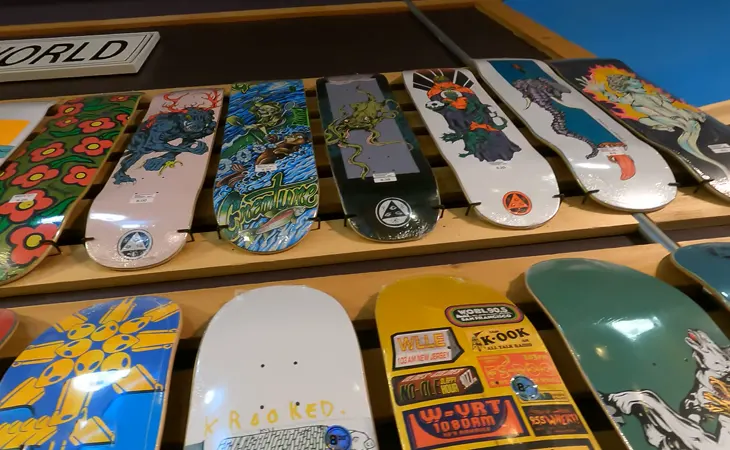13 Different Types Of Skateboards (Shortboards + Longboards)
Do you know that skateboarding started in the 1950s in California but grew in popularity in America in 1963? Four old roller skate wheels and a plain wood deck were the only components for the skateboards at first. However, different designs of skateboard decks have been developed and improved as skateboarding has progressed.
When you start shopping for a suitable skateboard, you’ll soon realize “how many types of skateboards are there”. With each sort serving a particular function. But which of the numerous skateboard varieties is best for you?
While you may appreciate how one board looks, it might not be the right choice for you. And knowing that is crucial before you hunt for a new arrangement.
This article will discuss the 13 different types of skateboards (9 shortboards and 4 longboards) to acquire one that suits your needs.
9 Types Of Shortboard Skateboards
Below is the list of 9 different types of shortboard skateboards:

01. Old-school skateboards
Compared to regular skateboards, these boards are substantially broader and have longer wheelbases and an 80s retro design.
Features:
- Old-school skateboards have a distinctive design with a broad head.
- It has one kicktail that can bounce the board for simple tricks and a smooth.
- They have decks that are up to 8.25 inches wide
Interestingly, these skateboards have higher and broader trucks, which makes them more stable and great for transit and bowl/pool skateboarding. These skateboards also have big, fat, squishy wheels designed to provide high speed.
However, these skateboards are more robust and have thicker decks than regular skateboards. The extra-wide deck and short nose of these skateboards make flipping or ollieing them challenging. As a result, these are not the best option for street skating, where skaters frequently perform flip tricks.
02. Penny or Nickle skateboards
The name “penny boards” originated with the recent rebirth of this skateboard type, even though the plastic skateboard’s design traces its history to the 1970s. The Penny Skateboards company 2010 produced the penny boards that are famous today. Consequently, the name came to represent the board.
Features:
- It has a diminutive size and plastic technicolor boards
- The penny board is 22″ long.
- The top of penny boards’ decks has a “waffle” pattern to provide a secure grip while doing tricks.
You can ride them without using any additional grip support. These boards, though, are slender and compact. i.e., they are at most unsteady. Therefore, more energetic skaters have the option of increasing their penny setup’s gripping to secure their footing.
The penny board style continues to be popular despite many hardcore skaters debating its place in the more significant skateboarding scene.
However, if you don’t want the plastic look of the penny board, you can get a nickel skateboard. The nickel board measures 27′′, making it somewhat taller than a penny. A penny’s characteristics are present along with a larger frame, including the crazy colors, plastic deck, and waffle grip.
03. Double kick skateboards
Go for double-kick skateboards if you like to accomplish stunts that lift your skateboard off the floor. When I say a skateboard has a double kick, I mean that two ends of the deck are raised rather than plain.
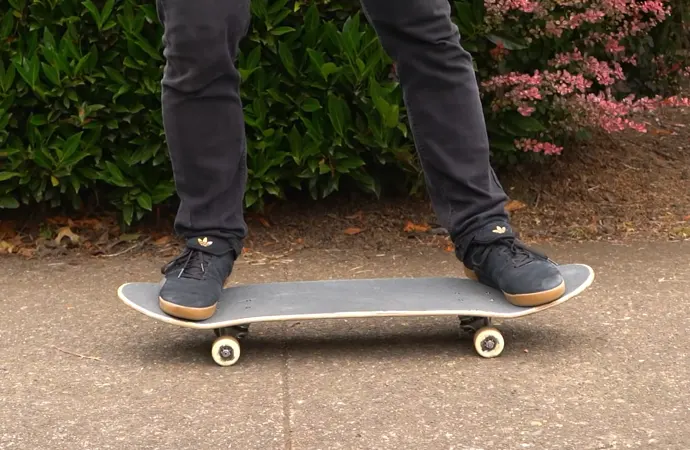
Features:
- Double kick skateboards have angled sides
- The thick decks and harder skateboard wheels make it perfect for performing stunts.
- It is a lightweight skateboard with a symmetrical shape from start to end.
You can grind rails, learn new tricks that an entirely straight board cannot, and push your board off the ground by using slopes at the sides of your board.
Double-kick skateboards come with either flat or steeply concaved decks. You’ll have more power when performing tricks on decks that have a deep concave.
04. Steep kick skateboards
If you want to do ground tricks, this skateboard is the one for you.
Features:
- Steep kick skateboards have taller and more vertical edges.
- You can accomplish skateboard tricks that demand higher lift while jumping off the ground since they.
When completing ground tricks, a skateboard with a sharp kick tail produces a powerful “burst.” However, a steep kick requires more work because it is delivered from a greater distance off the ground, resulting in a weaker pop.
Therefore, some skateboarders like steep kick skateboards, while others would prefer a flatter board.
However, when traveling at high speeds, riders can feel where they are on the board thanks to vertical kick tails, which makes doing tricks simple. A steep kick will be helpful if you’re looking for a pool skateboard.
05. Cruiser skateboards
The cruiser skateboard is unquestionably one of the most adaptable forms of skateboarding.
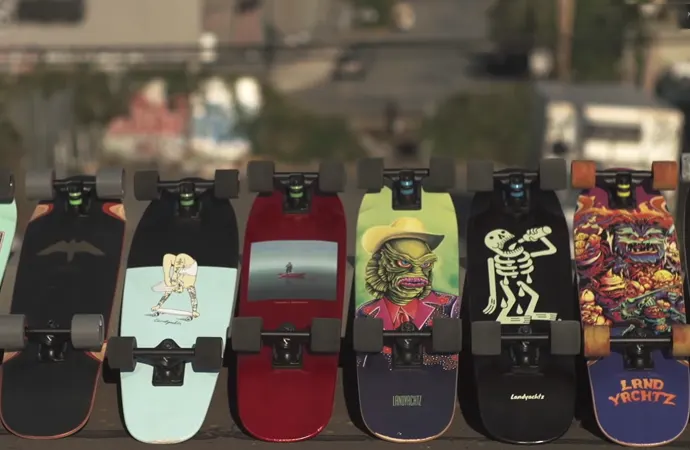
Features:
- They feature more prominent, softer wheels
- Enable you to cover more distance
- Provides perfect balance even for new skaters
They differ from many ordinary boards because they feature more expansive decks and large, soft wheels. Therefore, combining those two elements results in a comfortable riding experience.
The best way to get around town is to ride a cruiser board because they are simple to store when not in use. And they can easily transport you to your desired location.
The best beginning skateboards are cruisers if you’re shopping for your first skateboard. Even as learning on a cruiser board, novice skaters can find balance and boost their skills.
06. Mini cruiser skateboards
A mini-cruiser board is ideal for kids or anyone looking for a cheap, enjoyable way to get around town.
Features:
- Comprise of plastic
- Mini cruiser boards often travel at a pace of 4-6 miles per hour (7-9 km/h)
- Smaller than standard cruisers and have shorter, smoother wheels
Because Mini Cruisers are smaller than standard cruisers and have shorter, smoother wheels than other kinds of skateboards, they are typically more manageable and agile. Plastic is frequently used to make mini cruiser boards.
07. Street skateboards
One of the most simply ridden skateboards is the street skateboard.
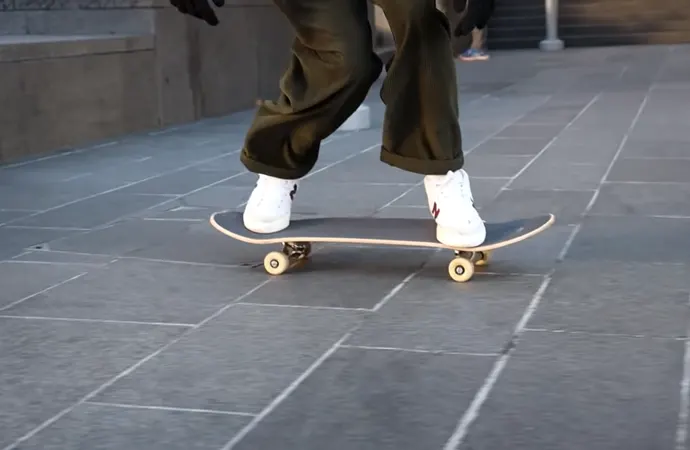
Features:
- Same tail and nose shape
- Thinner than most skateboards
- Provides speed and skill to the skater
These skateboards have several functions. They are simple to ride in bowls and across the city, so skaters take them to and from the skatepark. Despite the variations in the pattern, their nose and tail share a similar shape and are curved like popsicle sticks. Also slimmer than other types, these boards.
08. Carve Skateboard
A handmade wooden skateboard is all that a carved skateboard is.
Features:
- Handmade wood skateboards
- Boast lovely and aesthetic designs
- Heavier than other skateboards
Carves are crafted from hefty, solid wood and have lovely designs that range from bespoke to one-of-a-kind.
Due to the visible wood, carved skateboards are less stable than whole boards but have significantly better control and balance than other skateboards. However, carving boards are also quite heavy. Thus a top-notch deck is also required.
09. Electric Skateboard
In recent years, the best electric skateboard has emerged as one of the more well-liked varieties of skateboards.

Features:
- Operates with batteries and motor
- Lighter weight than regular boards
- Cover greater distance than conventional boards
Users of these skateboards may cover greater distances than conventional skateboards because of batteries and motors.
A charging dock often fastened to the board’s rear powers the electric motors. The capacity of this kind of skateboard to quickly ascend slopes is by far its most significant benefit. Additionally, controlling and maneuvering it is simple.
Due to their lighter weight than regular boards, electric skateboards have the drawback of not providing as much stability as classic penny boards. Electric skateboards often travel at 20 to 30 mph. They are not advised for novices, though.
4 Types Of Longboard Skateboards
A longboard is any skateboard that is longer than 33 inches. Additionally, compared to conventional skateboards, longboards have a larger chassis.
A longboard is typically used for long-distance travel, cruising, and zig-zagging. And downhill longboarding is a type of downhill skateboard racing that reaches very high speeds for the rider. These boards take up a lot of room, which makes them inconvenient for travel.
10. Classic longboards
Classic longboards are an excellent option for people looking for a skateboard that is simple to ride and entertaining.
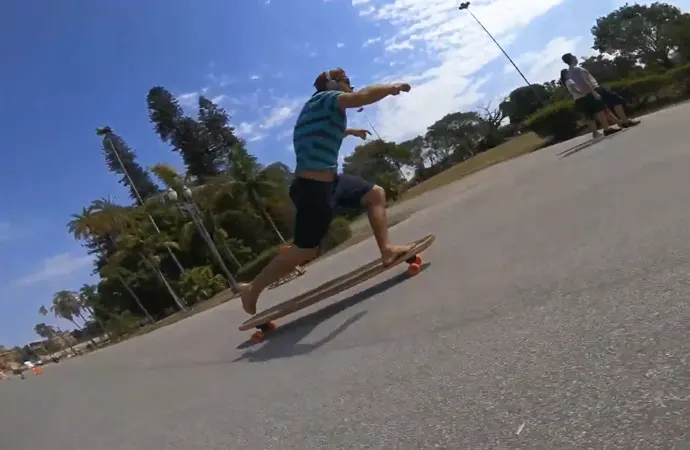
Features:
- Flexible and longer trucks
- Smooth riding experience thanks to soft wheels
- Simple to ride even for inexperience riders
Longboards, in contrast to shorter varieties of skateboards, are broader, have more flexible trucks, and are simply longer. Longboards also seem faster when riding because their wheels are softer.
While creating the classic longboard skateboard, the goal was to create a deck that felt as similar to surfing as possible but without the water. Classic longboards are flexible for inexperienced and experienced skaters due to their effortless riding style. You could even hang ten from them because they are that stable.
11. Downhill longboards
Although it is the same size as a standard skateboard, this particular downhill skateboard has a much larger wheelbase than most other skateboard designs. Their length is sturdy on rocky terrain or jumps and grinds.
Features:
- Features a larger wheelbase
- Sturdy wheels that can go over any uneven terrain
- Comprise of a heavier material like maple wood
These are typically built of heavier materials like maple wood for extra durability. Additionally, they frequently feature larger wheels since their stability necessitates more substantial support. Compared to small-diameter wheels, this enables them to withstand uneven terrain more manageable.
On the other side, if you fall backward while riding it downhill, it could be more demanding on your knees. Additionally, this kind of board cannot fast transform into a ramp since it lacks a kicktail. As a result, it’s best reserved for quick local tours.
12. Pintail longboards
These longboards have a classic appearance but have an oval shape with a pointed tip that allows the wheels to rest outside the board.

Features:
- They have a classic longboard appearance but with an oval shape
- It often comprises wood
- Wheels rest outside the decks so you can gain more speed
The deck layout of pintail longboards maximizes cruising and carving performance. So you can move around town, go at fast speeds, and even blast steep slopes.
Wheel biting is one of the drawbacks of some skateboards. Additionally, pintail longboards include features that help avoid tire contact with the surface. As a result, the deck comes to a point.
13. Twin-tip longboards
Consider getting a twin-tip longboard if you wish to bend in the carving or get pace up.
Features:
- Identical narrow nose and tail
- It has a broader deck from middle
- The trucks are installed outside the deck to prevent the wheel bite
Skateboards with twin tips have a large center and nearly identically thin tails and noses.
You can carve deeply without being concerned about wheel bite if your tail and nose are thin. Additionally, the wide base keeps your balance when traveling at high speeds.
Twin tip boards have a truck configuration that installs by passing through the deck in addition to the deck form, unlike other board designs, which have trucks attached to the deck’s underside.
Twin-tip longboards are the ideal skateboard for professional drivers, thanks to all these qualities.
- What Is The Best Age To Start Skateboarding?
- The Legality of Skateboarding In The USA
- Differences Between Ripstik VS Skateboard
FAQs Regarding Types Of Skateboards
Below I am mentioning some of the most frequent questions that may arise in your mind.

Question: What are good types of skateboards?
Answer: Depending on your experience level, you can choose a suitable skateboard type. For example, Standard skateboard decks with softer rollers are found on the best skateboards for novices.
Standard skateboards with almost equal popsicle stick-shaped boards perform nicely for street skating. Wider skateboard decks (8.5″ to 9.0″) and bigger skateboard wheels make the greatest skateboards for transitional skating.
The greatest skateboards for traveling and commuting include larger (58–65mm), softer (78–80a), and more forgiving wheels that make it easier to navigate obstacles like cracks in the road and rocks.
Question: What are the four types of skateboarding?
Answer: There are numerous types of skateboarding that an individual prefers to perform. The four main types of skateboarding are:
I. Freestyle Skateboarding:
Freestyle skateboarding, perhaps the earliest form of sport, originated in the 1960s as a means of transportation. Pro freestyle contests frequently featured music and choreography and emphasized mobility and physical proficiency.
II. Street Skateboarding:
Urban obstacles, including staircases and their railings, planter boxes, drainage canals, outdoor furniture, and other streetscapes, are used as skating obstacles on city streets.
III. Park Skateboarding:
Park skateboarding refers to a range of sub-styles used by skateboarders in specially designed skate parks.
IV. Downhill Skateboarding:
One of the earliest forms of skateboarding is non-competitive downhill, which peaked in popularity in the early 1970s. Initially, longboards were compared to snow skiers but now use ordinary skateboards.
Question: What are the three types of skating?
Answer: Skating is a sport where an individual travels on different surfaces using skates. The three types of skating are:
I. Ice Skating:
Ice skating is a sport where you travel on ice using ice skates.
II. Hard Surface Skating:
Hard surface skating involves different kinds of skating, such as roller skating, skateboarding, road skating, etc.
III. Snow Skating:
Snow skating entails surfacing on the snow using a hybrid of snowboarding and skateboarding.
Conclusion
There are skateboard varieties for every style if you’re looking for a downhill skateboarding, an old school board, or a park skateboard. Depending on your experience level, you should choose a skateboard.
Because if a newbie skateboarder gets a street skateboard, it will be difficult to ride them. Moreover, if you want a skateboard for simple traveling and cruising, you should get a skateboard with bigger wheels to commute faster.
Simply put, there are different skateboards for different reasons. And I hope that finding a skateboard that works for you is possible with our guide because you know the several varieties available.

